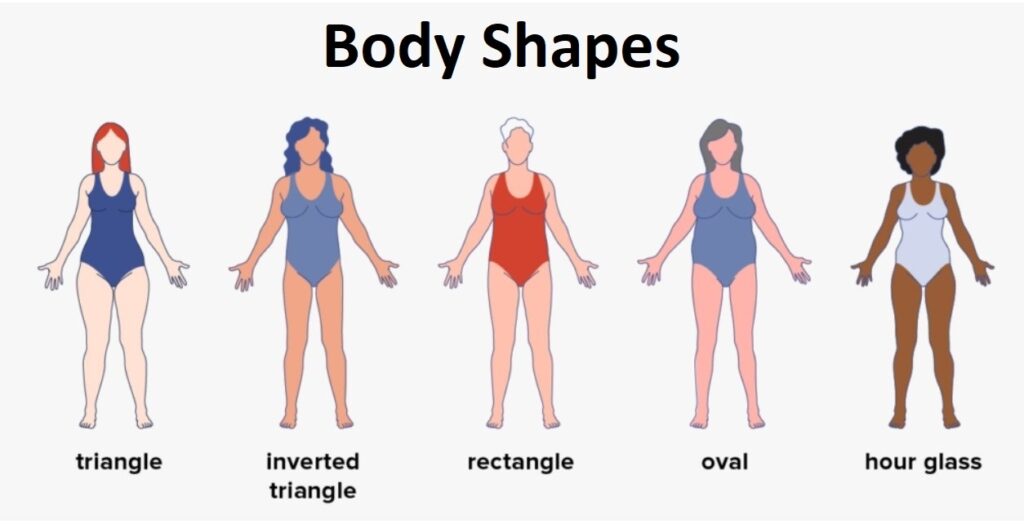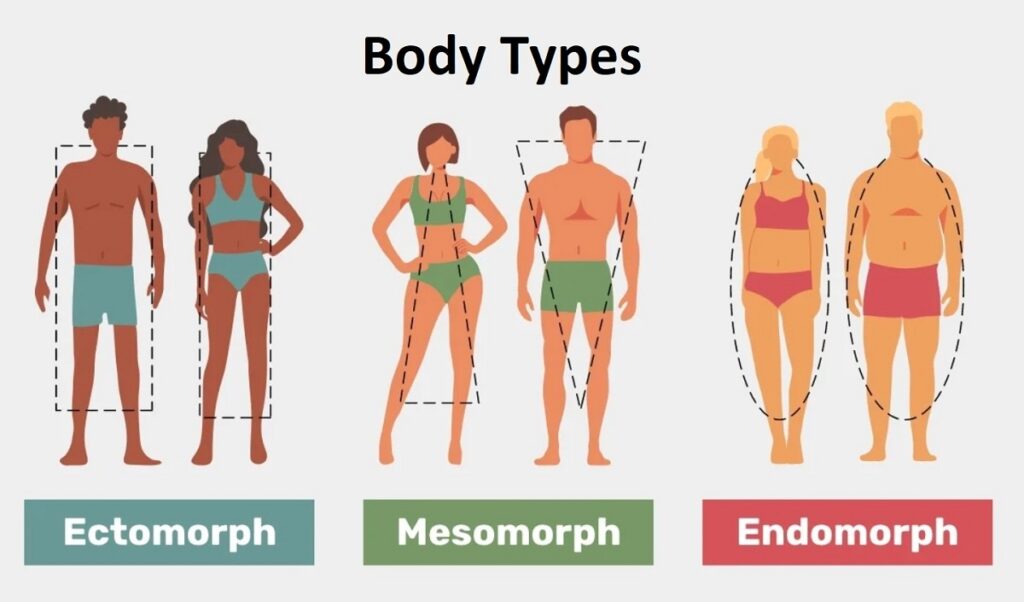Body Shape Type Calculator
Body shape types are typically determined based on the proportions of certain body measurements, particularly those of the bust, waist, and hips. The ratios of these measurements help categorize individuals into different body shapes.
Body Shape Type Calculator
Calculate and identify common body shape types
Here’s a general guide on how to calculate and identify common body shape types:
1. Measurements Needed:
Bust: Measure around the fullest part of your bust.
Waist: Measure around the narrowest part of your waist.
Hips: Measure around the widest part of your hips.
2. Calculate Waist-to-Hip Ratio (WHR):
WHR = Waist measurement / Hip measurement
3. Identify Your Body Shape:
Based on the WHR, you can determine your body shape. Here are common categories:
Hourglass Shape: WHR close to 0.7 (Bust and hips are similar, and the waist is significantly smaller).
Pear or Triangle Shape: WHR greater than 0.7 (Hips are wider than the bust).
Apple or Inverted Triangle Shape: WHR less than 0.7 (Bust is wider than the hips).
Rectangle Shape: WHR close to 1 (Bust, waist, and hips have similar measurements).
Consider Additional Factors:
While WHR is a common metric for determining body shape, consider other factors such as the fullness of the bust, the width of the shoulders, and the overall distribution of weight.
Use Body Shape Guides:
Many fashion and fitness resources provide visual guides and descriptions to help individuals identify their body shape. These guides often take into account not only WHR but also other characteristics such as shoulder and bust size.
Consult Fashion and Fitness Experts:
Fashion stylists and fitness professionals can offer personalized advice based on your measurements and overall physique. They can provide guidance on clothing choices, workout routines, and styling tips tailored to your body shape.
NOTE: It’s important to note that body shape types are generalizations, and individuals may not fit neatly into one specific category. People often have a combination of characteristics from different body shapes, and individual preferences also play a role in how one perceives their own body shape.
Body Shape Types
Body shape type refers to the overall silhouette or form of an individual’s body, often categorized into specific shapes based on the distribution of fat and muscle.
These categorizations are typically based on the proportions of the bust, waist, and hips. The concept of body shape type is often used in fashion and fitness industries to provide tailored advice on clothing choices, workouts, and health considerations.
There are several commonly recognized body shapes, and they are often categorized based on the distribution of fat and muscle in different areas of the body. While individual variations exist, the following are some common body shapes:

- Hourglass:
- Characteristics: Well-defined waist, with hips and bust of similar width.
- Common Traits: Balanced proportions between the upper and lower body.
- Pear (Triangle):
- Characteristics: Hips are wider than the bust, with a narrower upper body.
- Common Traits: More weight is carried in the hip and thigh area.
- Apple (Inverted Triangle):
- Characteristics: Bust is wider than the hips, with broader shoulders.
- Common Traits: More weight is carried in the upper body and around the midsection.
- Rectangle:
- Characteristics: Bust, waist, and hips have similar width without a well-defined waistline.
- Common Traits: Straighter or athletic build.
- Inverted Triangle:
- Characteristics: Shoulders and bust are wider than the hips.
- Common Traits: Broad upper body and narrower hips.
- Oval (Round):
- Characteristics: Fullness in the midsection, with a larger bust and rounder stomach.
- Common Traits: Weight is carried in the abdomen area.
- Diamond:
- Characteristics: Broad shoulders, narrower hips, and a fuller midsection.
- Common Traits: Weight is carried in the upper body and around the waist.
It’s important to note that these are general categories, and individuals may have a combination of characteristics that don’t fit neatly into one specific shape. Moreover, body shape can change over time due to factors such as age, lifestyle, and changes in weight.
Body Types
“Body type” is a more general term that encompasses various characteristics and attributes of an individual’s physique. It can refer to broader classifications such as endomorph, mesomorph, and ectomorph, which describe different body compositions and tendencies.
These classifications take into account factors like metabolism, bone structure, muscle mass, and fat distribution.
The idea of body types is commonly used in fitness and nutrition contexts to tailor exercise and dietary recommendations to suit individual variations.
There are different systems used to classify or describe body types based on various factors such as metabolism, bone structure, muscle mass, and fat distribution. Here are three common body types:

- Endomorph:
- Characteristics:
- Higher body fat percentage.
- Softer, rounder physique.
- May have a tendency to gain weight easily.
- Metabolism: Slower metabolism.
- Exercise: May need to focus on both cardiovascular exercise and resistance training to manage weight.
- Characteristics:
- Mesomorph:
- Characteristics:
- Muscular and well-defined physique.
- Broad shoulders and a narrow waist.
- Tends to gain muscle mass easily.
- Metabolism: Efficient metabolism.
- Exercise: Often excels in activities that involve strength and power.
- Characteristics:
- Ectomorph:
- Characteristics:
- Slim and lean build.
- Narrow shoulders and hips.
- Difficulty gaining both muscle and fat.
- Metabolism: Fast metabolism.
- Exercise: May benefit from more focus on resistance training to build muscle.
- Characteristics:
It’s important to note that these classifications are generalizations, and many individuals may not fit neatly into one category. Most people exhibit a combination of characteristics from different body types.
Body Shape Type vs. Body Type
Body Shape Type: Focuses on the external appearance and proportions of the body, often emphasizing the distribution of fat and muscle in specific areas, especially the torso and hips.
Body Type: Encompasses a broader set of characteristics, including factors like metabolism, bone structure, and muscle mass. Body type classifications (endomorph, mesomorph, ectomorph) provide a more comprehensive understanding of an individual’s physical attributes.
In summary, while “body shape type” often refers to external appearance and specific proportions, “body type” is a more comprehensive term that considers a range of physiological and genetic factors influencing an individual’s physique. Each concept serves different purposes in various contexts, such as fashion, fitness, and health.
Importance to know your Body Shape Types and Body Types
Knowing your body shape type and body type can be important for several reasons, including:
Fashion and Style Choices:
Understanding your body shape helps you make informed decisions about clothing styles that complement your proportions and highlight your best features. It can enhance your overall appearance and boost confidence.
Fitness and Exercise Planning:
Tailoring your workout routine based on your body shape can help achieve balanced muscle development and address specific areas of concern. Different body shapes may respond differently to various exercise regimens.
Health Awareness:
Certain body shapes may be associated with specific health risks. For example, carrying excess weight around the midsection (apple shape) may be linked to a higher risk of cardiovascular issues. Being aware of your body shape can prompt you to focus on maintaining a healthy lifestyle.
Body Positivity and Self-Acceptance:
Knowing your body shape can contribute to a more positive body image and self-acceptance. It encourages an appreciation for the unique characteristics of your body and helps dispel unrealistic beauty standards.
Weight Management Strategies:
Different body shapes may respond differently to weight loss or gain strategies. Knowing your body shape can help you set realistic weight management goals and adopt approaches that are more effective for your specific physique.
Targeted Fitness Goals:
For those pursuing fitness goals, understanding your body shape can help set realistic expectations and goals. It allows you to focus on achieving a balanced physique rather than adhering to unrealistic ideals.
Personalized Nutrition Plans:
Body shape can influence how your body stores and burns fat. Knowing your body shape may help in customizing your nutrition plan to support your specific metabolic needs and weight management goals.
Confidence Boost:
Embracing and understanding your body shape can boost self-confidence. It allows you to appreciate your unique attributes and present yourself in a way that aligns with your natural features.
